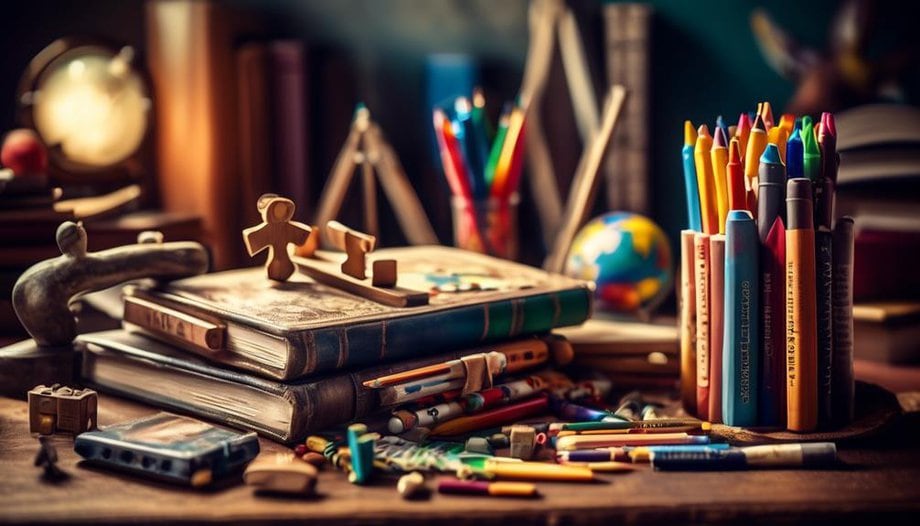Why Understanding Your Child's Learning Style Is Important

Understanding your child's learning style is important. It allows you to tailor their education to their individual needs. This maximizes their potential for success.
Key Takeaways
- Tailoring education to individual needs maximizes learning potential
- Identifying learning styles helps address weaknesses and enhance understanding
- Personalized learning approaches cater to individual learning styles and pace
- Understanding learning styles helps tailor education and enhance academic success
Importance of Identifying Learning Styles
Identifying your child's learning style is crucial in order to tailor their education to their individual needs and maximize their learning potential. Every child has unique strengths and weaknesses when it comes to acquiring knowledge and understanding concepts.
By understanding your child's learning style, you can customize their curriculum to suit their specific needs, ensuring that they're engaged, motivated, and able to grasp concepts more effectively.
Tailoring the curriculum to your child's learning style allows them to learn in a way that aligns with their strengths. For example, if your child is a visual learner, incorporating visual aids such as diagrams, charts, and videos can enhance their understanding and retention of information. On the other hand, if your child is an auditory learner, incorporating audio recordings or discussions can help them grasp concepts more effectively.
Furthermore, identifying your child's learning style can also help you identify their weaknesses. For instance, if your child struggles with reading comprehension, you can focus on strategies that cater to their specific needs, such as providing them with additional practice materials or using interactive reading exercises.
Tailoring Education to Individual Needs
To best support your child's learning, it's essential to adopt a personalized approach that takes into account their unique needs.
By tailoring education to individual needs, you can provide instruction techniques that cater to their specific learning style.
This ensures that they receive the most effective and engaging learning experience possible, allowing them to thrive academically.
Personalized Learning Approach
Tailoring education to meet the individual needs of each child is a key component of a personalized learning approach, allowing for a more effective and engaging educational experience.
When education is personalized, it brings a host of benefits to the table. It enables educators to adapt the curriculum to suit the unique learning style and pace of each student. This means that children can learn at their own speed, ensuring they fully grasp and internalize the concepts being taught.
Additionally, personalized learning allows for the incorporation of students' interests and preferences into the curriculum, making the learning process more relatable and enjoyable. By adapting the curriculum to cater to individual needs, personalized learning fosters a sense of ownership and empowerment in students, enhancing their motivation and overall academic success.
Individualized Instruction Techniques
By understanding your child's unique learning style, you can effectively tailor their education to meet their individual needs. Personalized assessment methods play a crucial role in determining the most effective teaching strategies for your child.
These assessment methods involve observing your child's learning preferences, strengths, and areas for improvement. Through personalized assessments, you can gain valuable insights into how your child learns best, whether they're visual learners, auditory learners, or kinesthetic learners.
Once you have a clear understanding of their learning style, you can implement effective teaching strategies that cater to their specific needs. For example, if your child is a visual learner, incorporating visual aids and diagrams into their lessons can enhance their understanding and retention of information. Similarly, if your child is an auditory learner, incorporating audio recordings or discussions can facilitate their learning process.
Enhancing Academic Success Through Personalized Learning
To enhance your child's academic success, it's crucial to implement personalized learning methods that cater to their individual needs.
By understanding your child's learning style, you can tailor their education to optimize their learning experience.
Whether it's visual, auditory, or kinesthetic, providing them with the appropriate resources and teaching techniques can greatly enhance their ability to absorb and retain information.
Individualized Teaching Methods
Understanding your child's learning style is crucial for implementing individualized teaching methods that enhance academic success through personalized learning. By using individualized assessment techniques, you can gain insights into your child's strengths, weaknesses, and preferred learning methods. This knowledge allows you to adapt the curriculum to meet their specific needs and interests, creating a tailored educational experience.
To bring this concept to life, imagine a classroom where each child's learning style is recognized and accommodated. In one corner, you see a group of kinesthetic learners engaging in hands-on activities, while in another corner, visual learners are utilizing visual aids and diagrams. Meanwhile, auditory learners are engaged in discussions and debates. Each child is given the opportunity to learn in a way that suits them best, fostering a deep understanding and love for learning.
Catering to Different Learners
Catering to different learners is essential for enhancing academic success through personalized learning. It allows for tailored instruction that meets each individual student's unique needs and learning style. Differentiating instruction is the key to ensuring that all students receive the support and resources they require to thrive academically.
By adapting teaching methods to suit the specific learning style of each student, educators can create a more inclusive and engaging learning environment. Some students may be visual learners, while others may prefer auditory or kinesthetic learning. By incorporating a variety of teaching strategies, such as visual aids, group discussions, hands-on activities, and technology-based resources, educators can ensure that all students are actively involved in the learning process.
This approach not only increases students' comprehension and retention of information but also fosters a sense of empowerment and motivation, leading to greater academic success.
Visual Learners: Strategies for Optimal Learning
For visual learners, incorporating effective strategies can greatly enhance their learning experience and maximize their potential for academic success. Understanding and utilizing the right techniques can make a significant difference in their ability to absorb and retain information.
Here are some strategies that can help visual learners excel:
- Utilize visual aids: Visual learners benefit from seeing information in a visual format. Incorporate diagrams, charts, and graphs into your study materials to make concepts more tangible and easier to understand.
- Use color coding: Color coding can be a powerful tool for visual learners. Assign different colors to different topics or categories to help organize information and make it more visually appealing.
- Embrace hands-on learning: Visual learners often thrive in a hands-on learning environment. Engage in activities that allow you to manipulate objects or physically interact with the subject matter. This can include experiments, art projects, or even building models.
- Mind mapping: Mind mapping is a visual technique that involves creating a diagram to visually represent relationships between different ideas or concepts. This can help visual learners see the bigger picture and make connections between different pieces of information.
- Incorporate visual mnemonics: Mnemonics are memory aids that help learners remember information. For visual learners, incorporating visual cues into mnemonics can be particularly helpful. Create visual associations or images that represent key concepts or facts.
Auditory Learners: Maximizing Learning Potential
To maximize the learning potential of auditory learners, incorporating strategies that cater to their preferred learning style is essential. Auditory learners thrive in an environment where they can hear information and process it through listening. They have a strong preference for spoken words, discussions, and lectures.
If you're an educator or a parent looking to support an auditory learner, there are several effective auditory learning techniques that you can implement.
One effective technique is to provide auditory cues and instructions. Clearly explaining concepts through verbal communication helps auditory learners grasp the information more effectively. Additionally, incorporating group discussions and debates allows them to engage in active listening and verbal exchange, enhancing their understanding and retention of the material.
Another technique is to use audio recordings or podcasts. Providing audio resources allows auditory learners to repeatedly listen to the content, reinforcing their understanding and memory. Audiobooks can also be a valuable tool for auditory learners, enabling them to absorb information through listening while following along with the text.
Utilizing mnemonic devices, such as rhymes or songs, can also be beneficial for auditory learners. By associating information with rhythm and melody, they can remember and recall the material more easily.
Kinesthetic Learners: Hands-On Approaches to Learning
Engaging kinesthetic learners through hands-on approaches is crucial for maximizing their learning potential. These learners thrive when they can physically interact with their environment and manipulate objects. Here are some effective strategies for incorporating hands-on learning and experiential education for kinesthetic learners:
- Manipulatives: Providing tangible objects such as blocks, puzzles, or models allows kinesthetic learners to explore concepts through touch and movement. For example, using blocks to build structures can help them understand mathematical concepts like geometry or spatial relationships.
- Role-Playing: Kinesthetic learners often benefit from acting out scenarios or role-playing. This allows them to physically experience and understand different situations. For instance, reenacting historical events or scientific experiments helps them grasp complex ideas more effectively.
- Field Trips: Taking kinesthetic learners on field trips or outdoor activities provides them with real-world experiences that enhance their learning. Whether it's visiting a museum, participating in nature walks, or engaging in community service projects, these hands-on experiences deepen their understanding of various subjects.
- Hands-on Experiments: Conducting experiments and engaging in hands-on activities allows kinesthetic learners to actively explore scientific concepts. By manipulating materials and observing cause-and-effect relationships firsthand, they can better comprehend scientific principles and develop critical thinking skills.
Supporting Your Child's Learning Journey
As you continue to support your child's learning journey, it's important to understand their unique learning style and provide them with the appropriate tools and resources to thrive in their education. One of the key aspects of supporting your child's learning journey is promoting student engagement.
When students are engaged in their learning, they're more likely to be motivated, focused, and actively participate in their education. You can promote student engagement by incorporating activities and materials that align with your child's learning style. For example, if your child is a visual learner, you can provide them with visual aids, such as charts or diagrams, to enhance their understanding of the subject matter.
Another important aspect of supporting your child's learning journey is fostering a love of learning. When children enjoy the process of learning, they're more likely to be curious, ask questions, and take ownership of their education. You can foster a love of learning by creating a positive and supportive learning environment at home.
Encourage your child to explore their interests and provide them with opportunities to pursue their passions. Additionally, celebrate their achievements and encourage them to set goals for their learning.
Frequently Asked Questions
How Can Parents Identify Their Child's Learning Style?
To identify your child's learning style, observe how they engage with information. Notice if they prefer visual, auditory, or hands-on learning. Understanding their style is crucial for tailoring their education to maximize their potential.
What Are the Benefits of Tailoring Education to a Child's Individual Needs?
You'll be amazed at how tailoring education to your child's individual needs can benefit them. Personalized education helps them learn and grow at their own pace, boosting their confidence and unlocking their full potential.
Are There Any Specific Strategies or Techniques That Can Enhance Academic Success Through Personalized Learning?
To enhance academic success through personalized learning, try using individualized instruction techniques that cater to your child's unique learning style. Differentiating instruction for diverse learners can help them thrive and reach their full potential.
How Can Visual Learners Optimize Their Learning Experience?
To optimize your learning experience as a visual learner, incorporate visual learning techniques such as using visual aids in education. This will help you process information more effectively and retain it better.
What Are Some Practical Ways to Maximize the Learning Potential of Auditory Learners?
To maximize the learning potential of auditory learners, actively listen to their needs and incorporate audio resources. For example, encourage them to participate in discussions and use podcasts or audiobooks as study aids.











